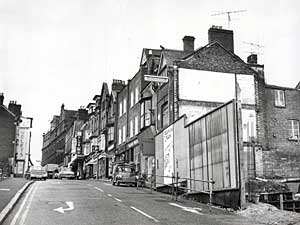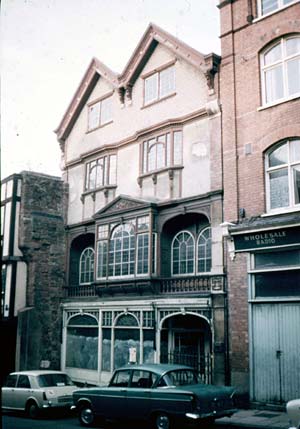
North Street - Northgate Street
Page updated 16 May 2009
Also see North Street in the 1920's
 The street that leads
to the site of the old North Gate, which was demolished in 1769. It was
formerly called Northgate Street. During the fourteenth-century the
tenement on the corner of High Street and North Street (now
Athena) was rented by Canon Thomas Stapledon for £1 8s. He used it
for the maintenance of his obit and the obits of his family. The same
corner became in later years the home of a statue of St Peter which dates from the late 15th
or early 16th century. It was moved to the front of the building on the
High Street in 1892.
The street that leads
to the site of the old North Gate, which was demolished in 1769. It was
formerly called Northgate Street. During the fourteenth-century the
tenement on the corner of High Street and North Street (now
Athena) was rented by Canon Thomas Stapledon for £1 8s. He used it
for the maintenance of his obit and the obits of his family. The same
corner became in later years the home of a statue of St Peter which dates from the late 15th
or early 16th century. It was moved to the front of the building on the
High Street in 1892.
When St David's Down was largely an agricultural area, lime from Larkbeare and Countess Wear was transported up South Street and down North Street on truckermucks or carts without wheels. Drawn by oxen, they often tipped over, blocking the street and spreading lime over the surface, as well as breaking up the cobbled surface.
The street was first widened in 1821 with the removal or demolition of the front of the medieval buildings.
The top of North Street at the junction with Fore Street, South Street and the High Street was called the Carfax, where a water supply was provided through a conduit that was paid for by friars and nuns of Exeter.
Cholera
During the early summer of 1832, the newspapers and the Chamber had already been commenting on cholera reaching the city for about a year, following reports of the disease in St Petersburgh, Russia. On the 19th July it was reported that the first case of cholera had been found in North Street. The victim, a young woman named Ruse, and her two children became ill after they recently returned from Plymouth. By October, when the disease burnt itself out, another three had died in the street, and two in Lower North Street; across Exeter things were very different with 402 deaths in total. Not only was Ruse the first, but she was probably responsible for spreading the disease because sewage from North Street flowed into the Longbrook and hence, contaminated the water in the leats, from which the poor dipped.
By 1851, the Eagle Brewery was established in the street, run by Pinder and Hull from the rear of the Elephant Inn. By 1876, it became the G and C Finch brewery. There had always ben a variety of inns and public houses in the street, with probably the most famous of the early ones, the George Inn which was sited where the modern Gaumont is found, and the later Elephant and Black Dog Inns.
The Streets Committee considered a memorial from the residents of North Street, in 1875. They complained that the street was becoming dangerous and that it should be widened by cutting back the buildings on the left hand side so that they lined up with the Crown and Sceptre. In the event, only the radius of the corner with Bartholomew Street was increased to make turning easier. Next to go was one of the many lost churches of Exeter, St Kerrian's, dedicated to a Celtic saint from Glastonbury, which was demolished in 1878.
A major widening took place in the 1890's when some 17th-century buildings on the west side lost 8ft of frontage. The shops on this side have Victorian fronts with 17th-century, timber framed rears, some with original stone sinks, while one retains an original staircase.
A Great Fire in Exeter
On the 18 January, 1882 on the corner of North Street and Fore Street a fire broke out that would result in the construction of one of the most well known buildings in this part of the city. A fire in an iron-mongers quickly spread through several buildings, forcing inhabitants to escape. One young mother died of burns and cuts from jumping through a glass roof. The fire spread to the corner building occupied by Wheaton's book and stationery store and Mr May's, ironmongery and dealer in lamp oils, quickly destroying both premises. The alarm had been given at 4.15pm, and the West of England, and Norwich engines, along with a detachment of men from the Devonshire Regiment fought to quench the inferno with no effect. By 7pm five buildings were totally gutted; the damage was estimated to have cost £20,000.
The whole corner block was rebuilt, for Wheaton's and Brock's Furniture store, into the handsome, red brick building with a corner tower that is now such a landmark. In 1905, Wheaton's vacated their shop to be replaced by Cornish's the outfitters. Now Snappy Snaps occupy the shop on the corner and B-Wise is in the old Brock's store. Most of the rest of ancient shops and houses on the east side of North Street were lost when the Guildhall Shopping Centre was built in the 1970's. Lost buildings included the Elephant Inn and no 35 and 36, which dated from the late 15th century. Along with William Pollard, the printers, these buildings have been replaced by Woolworths. In medieval times, North Street was very narrow, and many of the houses where merchants houses with overhanging first floors and solariums over, closing in the street below. It must have been almost possible to shake hands with the people opposite, from the top floors, as the street was only 3 metres wide at the bottom.
World War One Dead - North Street
Private,
H H Chapman, Devonshire Regiment. 3 October 1915. Age 34. Garden
Square, North St
Private, Arthur James Coombes, Devonshire Regiment.
14 November 1914. Age 28. Lower North St
Stoker 1st Class, John
Evans, H.M.S. "Indefatigable.", Royal Navy. 31 May 1916. Age 21. Garden
Square, North St
Sapper, Frederick Johns, Royal Engineers. 7 June
1917. Age 21. Lower North St
Corporal, Henry James Lascelles, Royal
Warwickshire Regiment. 31 January 1920. Age 40. Garden Square, North St
Private,
Walter Lear, Duke of Cornwall's Light Infantry. 19 March 1917. Age 33.
Garden Square, North St
Private, Charles Henry Matters, Somerset
Light Infantry. 4 October 1917. Age 21. North S
tLance Serjeant,
William Henry Morrish, Devonshire Regiment. 10 September 1918. Age 34.
45, North StLance
Corporal, John Sanford, Devonshire Regiment. 14
July 1916. Age 34. Garden Square, North St
Private, Ernest Edward
Scott, Devonshire Regiment. 25 September 1915. Age 29. Union Place,
North St
Private, B White, Devonshire Regiment. 25 April 1917. Age
33. Lower North St
Source: Various sources including Two Thousand Years in Exeter by W G Hoskins and Exeter Architecture by Hugh Meller.
 Looking up North Street circa 1965 – the Guildhall Centre was
still in the planning stage, and the car park on the right was still to
be constructed. Photo Express and Echo.
Looking up North Street circa 1965 – the Guildhall Centre was
still in the planning stage, and the car park on the right was still to
be constructed. Photo Express and Echo.  Mansfield's
Antiques, North Street, was demolished for the Golden Heart
development. Photo courtesy of Alan H Mazonowicz
Mansfield's
Antiques, North Street, was demolished for the Golden Heart
development. Photo courtesy of Alan H Mazonowicz
Blackmore's Buildings
Chapel's Court
Cornish's Place
Garden Square
Kerrian's Place
Union Place
Warren's Place
Inns and pubs of North Street
Angel Inn
Barnstaple Inn
Black Dog Tavern
Crediton Inn
Elephant Inn
Falcon Inn
George Inn
Hexter's Vaults (Tiger Bills)Plume
of Feathers
Spotted
Dog
│ Top of Page │